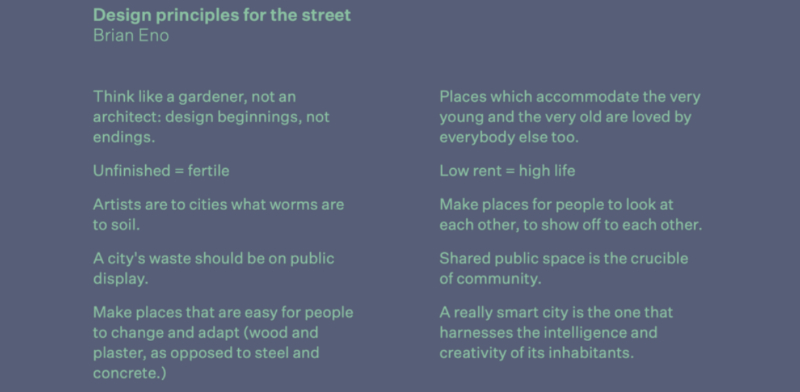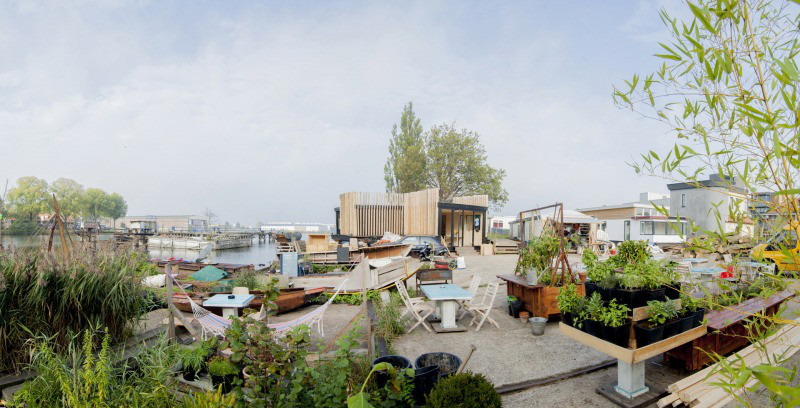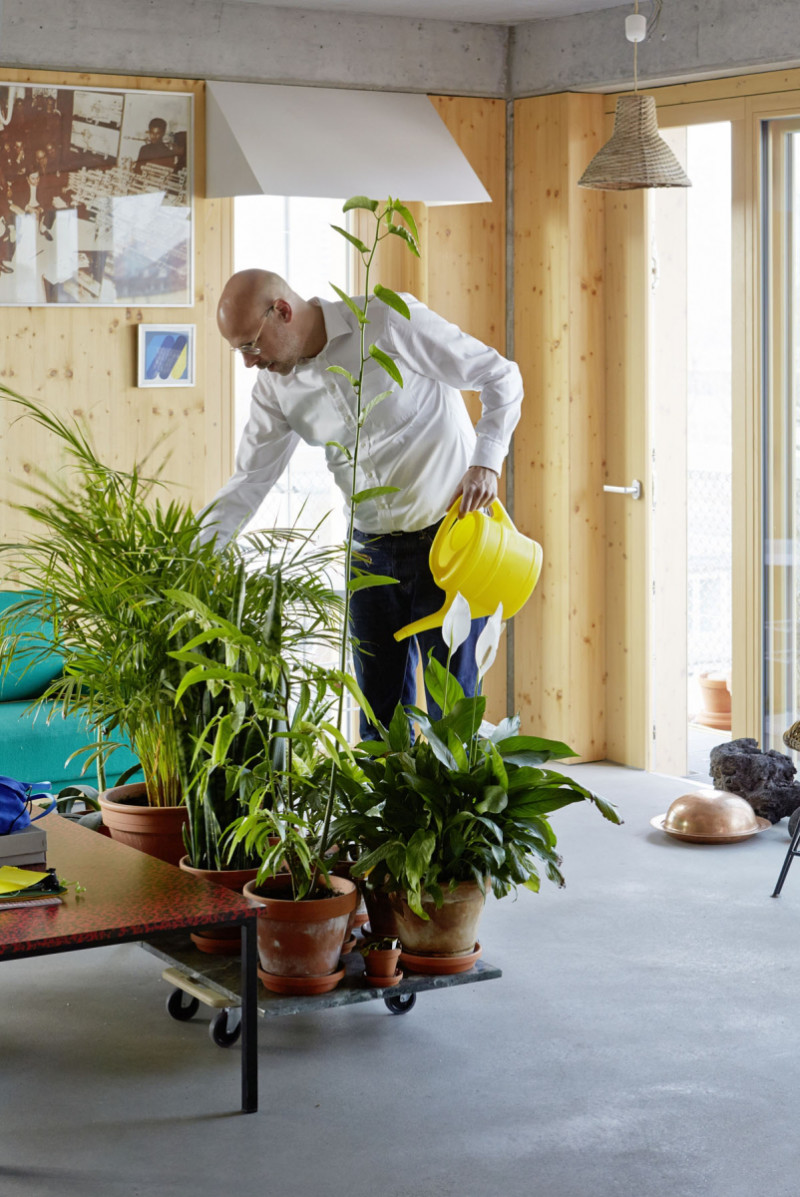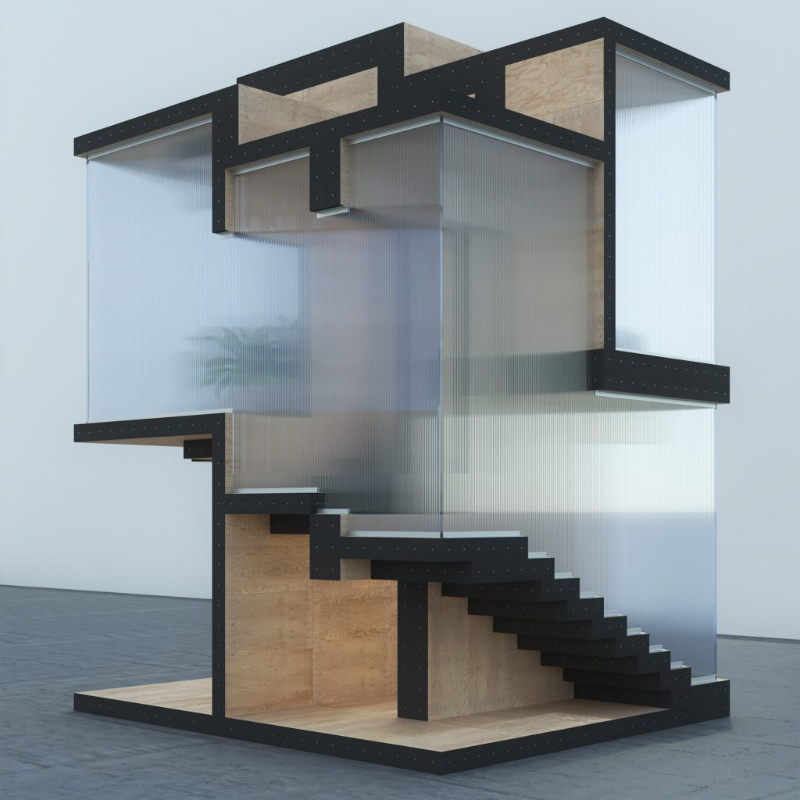009 A Smart City is an Unfinished City
Hello Reader
I realised that this newsletter can be hard to pin down. It zigs from cities, low carbon transportation, to systems, and to nature as a means of inspiration. Trying to wrangle these big themes into some sort of meaningful shape is tough. Tough in the sense that I’m constantly asking whether these topics hang together in a meaningful and engaging way? I’m reminded of the famous interview David Bowie gave about pushing to the edges of your comfort zone .
When I write, there’s a faint outline of a theme based on notes I’ve harvested. I will churn through several drafts until something takes shape. Sometimes I might see something that validates what I’ve been writing about, and does so crisply and succinctly. To that end, Dan Hill shared Brian Eno’s thoughts on what he believes are the foundations for a smart city.

Source: Dan Hill
There’s so much good thinking that I wanted to unpack each one in a bit more detail.
Think like a gardener, not an architect: design beginnings, not endings
The mindset needed for the built environment, or any creative endeavour for that matter, is to allow for ongoing adaptation.
“We make cities in order to come together, to create conviviality, culture, community, commerce…and now to regenerate and reinvent, care and repair, rather than extract and mitigate…” - Dan Hill
Examples of this include Hong Kong’s famous walled city of Kowloon was a neighbourhood system that looked after itself until it was torn down by the authorities for development.
Another example is De Ceuvel which I’ve written previously on, a creative neighbourhood built on a small island destined for development. The developers realised that the soil was so contaminated it needed a decade long process of decontamination. Plants were introduced to the island that gradually absorbs the pollution and restores the soil back to health. The developers granted a 10-year lease to the creative organisation behind De Ceuvel to occupy and create a temporary space while the decontamination process unfolded.
What you have today is a beautiful boardwalk that snakes its way through the tall grass, connecting converted old houseboats that are now a collection of studios and offices.

Source:Architecture In Development
Unfinished = fertile
Today, most developments take the design decisions out of the hands of the consumer and charge a healthy margin. But as inhabitants come and go and design choices evolve, the financial and environmental cost of reconfiguring property is high. A different approach adopted by Berlin’s R50 housing development is to leave units in their shell state. Owners have the flexibility of designing their space to their requirements while benefiting from the lower costs of not having a fully built and specced out property.

Source:MetropolisMag.com
“The architects developed a concrete shell structure with modular wooden elements and a wire mesh facade to accommodate the variations of internal layout the studies called for. The residents opted to make the ground floor a shared space” units were delivered finished, but not entirely “done,”
Artists are cities what worms are to soil
Urban spaces must be inviting spaces for creative expression. When you imagine ideal cities to visit or inhabit, the majority are likely to have a strong cultural pull. Providing the conditions for them to thrive is key. That means embracing all forms of creativity and protecting them. There are recent examples where artistic communities have brought with them not just cultural enrichment but economic prosperity. A case in point is the £7m arts centre created in South West England (FT Paywall) that tapped the unmet need for an art space and now provides jobs in the local area.
It goes without saying that having affordable housing and rental controls in place are also key levers in ensuring artists are not priced out of neighbourhoods.
A city’s waste should be on public display
Out of sight and out of mind has been the prevailing attitude to the waste we generate. By insulating ourselves from the mess we create, we’ve simply stored up problems rather than address the real cause of our excessive consumption and throwaway culture. The amount of waste generated in the production of a single laptop is four thousand times the weight of the finished product. - Source Natural Capitalism (Hawken, Lovins). An alternative model of regenerative design such as the circular economy closes the loop on the waste generated.
Taking this a step further, I’ve mentioned in a previous issue, the East Kolkata Wetlands in India. This aquaculture system processes 80% of Kolkata’s sewage . Its integrated fish ponds provide 40% of the region’s fish production and it provides 200,000 people with a livelihood. That model for recycling waste and converting it into food and other by-products may seem unappealing to many, but it does point to a direction of travel where the biophysical limits of the planet are less at risk.
Make places that are easy for people to change and adapt (wood and plaster, as opposed to steel and concrete)
Like software, architects are finding ways of designing buildings as an operating system for change. Wikihouse has codified a set of design principles to ensure it is continuously finding ways to lower energy, waste, and carbon at every stage of the build process. Its modular approach to design and build extends to using local micro-factories and minimising complexity by using as few unique materials as possible.
Dutch Superlofts works with developers to test a site’s potential and to make use of the climate and surroundings as much as possible. Its mission is to create the most sustainable and socially inclusive housing model for the future. This extends to providing the tools and approaches for a community to conceptualise shared spaces based on common interests and needs. House Block is asking the question of what could our environment look like if our homes were not static structures but could evolve over time?

Source:AutomatedArchitecture.io
Places which accommodate the very young and the very old are loved by everyone else too / Low rent = high life
The best places tend to be those that have a mix of generations. Certain parts of London have become enclaves in their own right through gentrification thereby pricing out of both the young and old. They are all the poorer for it.
Make places for people to look at each other, to show off to each other / Shared public space is the crucible of community
I’m struck by how a piazza or town square allows for rest or play or entertainment. To be observed or to be an observer. The typical UK high street seems purposely designed for little or no social interaction. The high street road seems to suck people along in continual motion, where there is no time or space to rest. Squares seem to be more adaptive and recognise that foot traffic is more important than road traffic.
While private landowners are adopting these design cues and creating similar spaces, they are too manicured, too rigid to be adapted and welcoming only to a minority of people. In short, places for all people to congregate are vital for health and vibrancy.
A really smart city harnesses the intelligence and creativity of its inhabitants
Culture is the glue for bringing people together and for making cities work harmoniously. By bringing the principles highlighted you create a modern and vibrant space to live
Whenever the topic of smart cities comes up, propagated by a tech company with a commercial agenda, the focus is on technology as the glue that holds things together. Eno’s set of principles rejects this by putting the emphasis on people and their creative endeavours being the real drivers of change
Miscellany
Industrial designer Dave Hakkens is documenting his attempt to establish a low carbon community. It’s lo-tech and completely immersive - Via Dense Discovery
I love mushrooms. Their versatility extends beyond being just something to eat. We now know that they function as a communications network for trees. What’s more, MIT have just published a paper that mushrooms could be the answer in fixing crumbling infrastructure.
An appreciation of the different sounds public transport systems use around the world. The one that always gets me is the Eurostar chirpy signature, which is just so French sounding NY Times